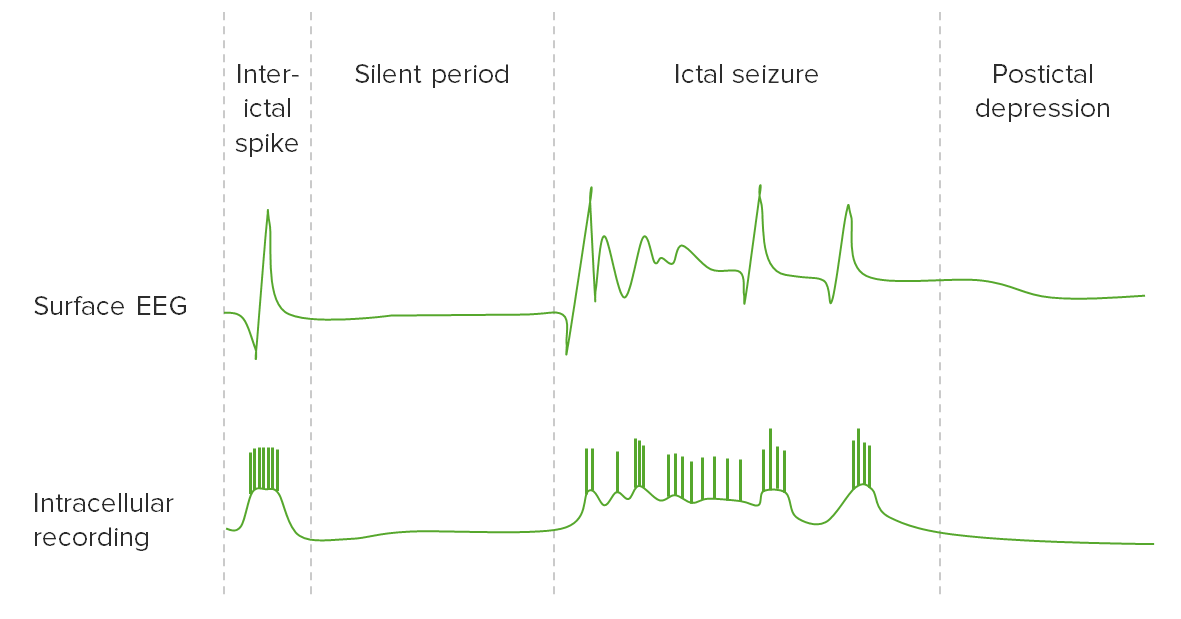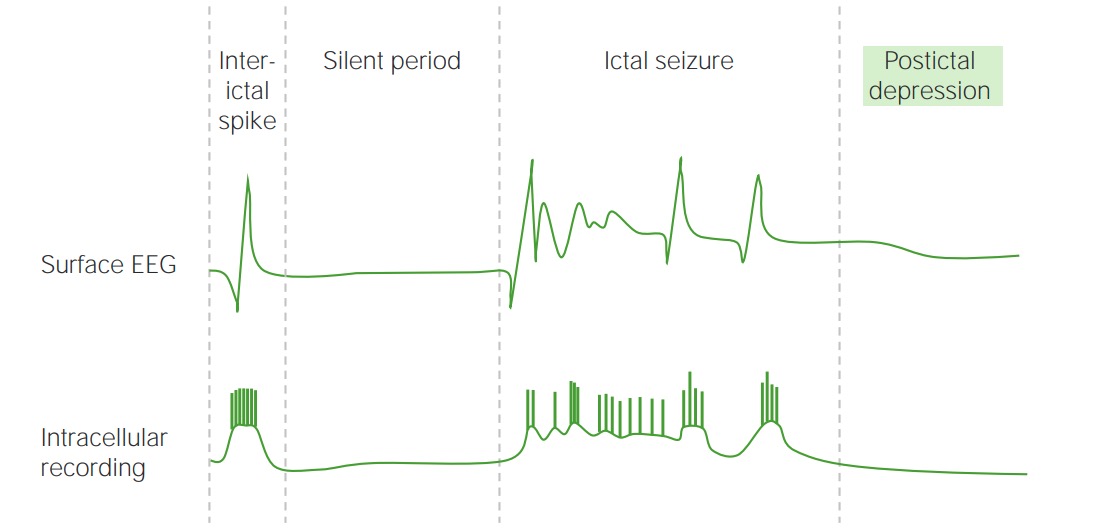Playlist
Show Playlist
Hide Playlist
Status Epilepticus: Treatment and Types
-
Slides Seizures Epilepsy Status Epilepticus.pdf
-
Download Lecture Overview
00:01 Now, let's focus on treatment. 00:03 We've talked about the early stabilization of patients with status and let's go into how we approach treatment both initially, and in cases of refractory, and super refractory status epilepticus. 00:14 Again, in the incipient phase that first five minutes of stabilization, we look to stabilize the patient with the ABCs, IV access oxygen, and rapid glucose check. 00:25 Rapid screening, history and physical is performed either with the patient or frequently with a caregiver. 00:30 In the early 5 to 15 minutes, we look at initial abortive pharmacotherapy. 00:35 Benzodiazepines to abort the seizure, the status and resolve status at that time. 00:41 Lorazepam is commonly given but you can see the list of medications that we can use in the setting. 00:47 We repeat each of these benzodiazepines once every five minutes or so up to three doses typically. 00:55 Antipyretics if the patient is febrile and other interventions can be considered in selective cases, such as neonates and then in adults. 01:04 During this phase, we also send electrolytes, drug levels, toxicology screen, CBC cultures looking for the potential cause of the status. 01:12 And if we can manage those causes, we may be able to abate the status early. 01:18 And then we move to definitive treatment of the status. 01:21 And I want to review one trial with you that is established the medications that we use for status epilepticus. 01:28 In this trial, 385 children and adults with benzodiazepine refractory status epilepticus were evaluated. 01:36 They were treated with 60 mg/kg of levetiracetam, 20 mg/kg of fosphenytoin and, and or 40 mg/kg of valproic acid. 01:44 So patients were randomized to one of these three treatments. 01:48 The study looked at absence of clinically evident seizures and improve responsiveness at 60 minutes. 01:54 So they wanted a medication that would work and all three drugs were equivalent. 01:59 47% of patients responded to levetiracetam, 45% of patients to fosphenytoin, and 46% of patients to valporic acid. 02:07 The thing to take home from this is these are the three definitive treatments of status epilepticus, with about 50% of patients responding. 02:14 That also means 50% of patients will continue to have status epilepticus after first definitive therapy. 02:22 There are no significant differences in late seizure cessation or in safety between either of these three medications and so we can use them interchangeably based on their side effect, profile, and availability. 02:34 For those patients who continue to have status epilepticus. 02:38 After two definitive anti-convulsive treatments, fosphenytoin, valproic acid, and or levetiracetam, we look at additional interventions. 02:47 We may start by adding additional fosphenytoin and or phenobarbital. 02:52 And then typically, we move to admitting the patient to ICU for intubation and continuous EEG monitoring. 02:59 Patients are put into a medically induced burst suppression. 03:02 So this is using a high dose of an intravenous anesthetic to quiet the brain and suppress brain activity. 03:09 Trying to reset the brain out of that status epilepticus. 03:12 There are a number of intravenous anesthetics that are use pentobarbital, IV medazepam, propofol, and high doses of other anti-epileptics can be used. 03:23 And the goal is to put the brain into burst suppression, low EEG activity, resetting the brain for 24 hours. 03:32 In rare cases, we'll consider other interventions and sometimes these are referred to the super-refractory status epilepticus. 03:38 And when stable, we typically obtain neuroimaging and LP. 03:42 Again, to look for potential causes of refractory status epilepticus that could be treated and help to resolve the patient's clinical situation. 03:52 For patients that fail treatment of refractory status epilepticus, we classify that as super-refractory status epilepticus. 04:00 That's defined as ongoing seizure activity. 04:02 Despite intravenous drips for 24-hours of burst suppression. 04:06 This is extremely difficult to treat. 04:09 And we're looking at other interventions that have not been used up till this time to manage these patients. 04:15 There's no one single agent and we tailor the treatment to the patient's clinical scenario. 04:21 We can consider the ketogenic diet, immunotherapy, lesional treatment, and that's a seizure surgery, or laser interstitial thermal therapy. 04:29 That's a laser to treat or ablate to kill a seizure nidus, or additional intravenous medication, another 24-hours of birth suppression. 04:41 Let's talk a little bit about a couple of those treatments. 04:43 They're interesting treatments that we use in these rare and exceptional cases. 04:47 The ketogenic diet. 04:48 We hear about commonly in the lay media, but this is used as a medical intervention for seizures, and for status epilepticus. 04:55 It is a high fat, low protein, low carbohydrate, almost no carbohydrate diet. 05:01 It shifts metabolism from glycolysis to fatty acid oxidation. 05:06 Instead of glucose circulating as the primary source of energy we see a rise in ketone bodies, which can be metabolized. 05:15 We replace glucose with ketone bodies and those become the primary energy source for the brain. 05:21 The brain is a glucose avid organ and this shift in metabolic activity can shift the brain and is a treatment for both seizures and kids and is used in cases of refractory status and super-refractory status epilepticus. 05:35 We can also consider surgical treatments for refractory status epilepticus, as well as other patients with epilepsy. 05:42 Resective surgery is a treatment for focal or lateralized, and localized epilepsies. 05:48 It may be more effective than prolonged medical therapy and things like temporal lobe epilepsy where there is a specific seizure nidus that can be safely removed with surgery. 05:59 Anteromedial temporal resection is considered in patients with intractable mesial temporal lobe epilepsy. 06:05 And patients may become seizure free not requiring further AED therapy with this intervention. 06:11 Typically, we would consider a patient medically refractory a seizure patient medically refractory. 06:16 After two trials of medications at sufficient doses. 06:21 That's a sufficient dose of medication one and a sufficient dose of medication two. 06:25 An epileptic patient who fail two drug therapies would be considered for a seizure surgery evaluation. 06:32 Early seizure surgery is more effective than delayed seizure surgery. 06:35 And so this is something that we consider in patients with refractory epilepsy, as well as in selected patients with status epilepticus Of the vagal nerve stimulator is also a surgical adjunct for treatment of partial onset epilepsies. 06:50 It appears effective and well tolerated for patients with partial seizures. 06:54 It reduces seizure frequency in patients with drug-resistant idiopathic epilepsy. 06:59 And some of the generalized epilepsies like Lennox-Gastaut. 07:03 So we use it in both partial onset and generalized epilepsies. 07:07 Vagal nerve stimulation is again considered for patients with medically refractory epilepsy. 07:12 And those are patients who have failed two drug trials at sufficient doses. 07:17 And rarely in cases of status epilepticus. 07:19 It's not as effective in status epilepticus as medically refractory epilepsy. 07:25 Brain stimulation is a new, a newer therapy to be considered for patients with epilepsy, it is a surgical treatment. 07:32 Patients have implanted intracranially a device a responsive neurostimulator. 07:38 This RNS system is able to read seizures through electrocorticography and deliver a stimulation to try and stop the seizure when it starts. 07:48 This treatment is capable of sensing those abnormal electrical discharges those spike and waves activities when they occur on the cortical surface. 07:56 And that automatic delivery of an electrical stimulation is intended to stop the seizure before it's able to spread. 08:03 Deep-brain stimulation is also another experimental treatment for the treatment of epilepsy. 08:09 We are looking at novel targets to treat patients with epilepsy and specifically the anterior thalamus which is involved in relays to the frontal lobe and other areas of the brain. 08:18 Deep-brain stimulation is placed surgically with a placement of an electrode that delivers a stimulation to reduce activity in a selective area of the brain. 08:27 It's used frequently for Parkinson's disease and certain tremors and has shown some success in patients with epilepsy. 08:35 And then lastly, let's talk a little bit about nonconvulsive status and other types of status epilepticus outside of the convulsive setting. 08:44 Nonconvulsive status is electro graphic status without prominent motor signs. 08:49 So the EEG shows seizures. 08:52 The patient's brain is having seizures, but we don't see that prominent motor activity With absence status epilepticus that status from primary generalized epilepsy from absences we see disorientation, staring, and blinking. 09:06 This may be triggered by certain medications. 09:09 Carbamazepine is a really important one. 09:11 This is a medicine that we use for seizures but not for management of primary generalized epilepsy, because it can make that worse. 09:18 We can also see this with toxic doses of phenytoin and other medications. 09:22 This does respond to benzodiazepines, Depakote, and other typical interventions for status epilepticus. 09:28 We manage it in the same way. 09:31 Complex partial status epilepticus can also cause nonconvulsive appearance on clinical exam. 09:37 Patients present with a confusional state or bizarre behavior and automatisms that continue again beyond 30 minutes without return to baseline. 09:44 It can ultimately progress to patients becoming comatose, paralyzed, or appearing sedated. 09:50 And then subtle generalized convulsive status epilepticus can mimic nonconvulsive status. 09:56 These are patients who presented with convulsive status epilepticus that is burned out. 10:00 We don't see those motor signs. 10:02 We only see the electrographic appearance.
About the Lecture
The lecture Status Epilepticus: Treatment and Types by Roy Strowd, MD is from the course Seizures and Epilepsy.
Included Quiz Questions
Which statement regarding management is the most accurate during the early stages of status epilepticus (SE)?
- Repeat dosing of abortive antiepileptic medication can be given during stage 2.
- ABCs, IV access, and glucose testing occur in stage 2.
- Abortive antiepileptic medication is given in stage 1.
- Thiamine is recommended for neonates.
- Pyridoxine is recommended for adults.
Which statement is the most accurate with respect to the management of status epilepticus (SE)?
- Approximately half of the patients treated for SE will progress to refractory SE.
- Definitive medical treatment for SE is successful in the vast majority of cases.
- Levetiracetam has a significantly higher efficacy.
- Valproate has a significantly higher efficacy.
- All three definitive medications have an efficacy rate of approximately 75%.
Which statement is the most accurate with respect to refractory status epilepticus (SE)?
- Neuroimaging may be performed to locate a possible nidus.
- Additional medications are avoided during this phase.
- A medically induced coma is initiated for 12 hours.
- Patients are usually less symptomatic at this stage and can be managed on the hospital floor.
- Refractory SE is a relatively safe period with minimal risk of brain damage.
Which statement is the most accurate with respect to super-refractory status epilepticus (SE)?
- In temporal lobe epilepsy, surgical resection may be more effective than prolonged medical therapy.
- Patients must fail 48 hours of burst suppression before they reach this classification.
- There is clear evidence of a specific treatment modality offering the highest efficacy.
- Increasing dietary carbohydrates may be an effective treatment approach during this stage.
- Outcomes of vagus nerve stimulation have been poor, resulting in abandonment of the modality.
Customer reviews
5,0 of 5 stars
| 5 Stars |
|
5 |
| 4 Stars |
|
0 |
| 3 Stars |
|
0 |
| 2 Stars |
|
0 |
| 1 Star |
|
0 |





